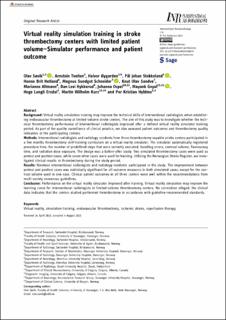| dc.contributor.author | Søvik, Olav | |
| dc.contributor.author | Tveiten, Arnstein | |
| dc.contributor.author | Øygarden, Halvor | |
| dc.contributor.author | Stokkeland, Pål Johan | |
| dc.contributor.author | Hetland, Hanne Brit | |
| dc.contributor.author | Schneider, Magnus Sundgot | |
| dc.contributor.author | Sandve, Knut Olav Lende | |
| dc.contributor.author | Altmann, Marianne | |
| dc.contributor.author | Hykkerud, Dan L | |
| dc.contributor.author | Ospel, Johanna | |
| dc.contributor.author | Goyal, Mayank | |
| dc.contributor.author | Ersdal, Hege Langli | |
| dc.contributor.author | Kurz, Martin | |
| dc.contributor.author | Hyldmo, Per Kristian | |
| dc.date.accessioned | 2024-02-19T12:12:47Z | |
| dc.date.available | 2024-02-19T12:12:47Z | |
| dc.date.created | 2023-09-25T15:05:04Z | |
| dc.date.issued | 2023 | |
| dc.identifier.citation | Søvik, O., Tveiten, A., Øygarden, H., Stokkeland, P. J., Hetland, H. B., Schneider, M. S., ... & Hyldmo, P. K. (2023). Virtual reality simulation training in stroke thrombectomy centers with limited patient volume—Simulator performance and patient outcome. Interventional Neuroradiology, 15910199231198275. | en_US |
| dc.identifier.issn | 1591-0199 | |
| dc.identifier.uri | https://hdl.handle.net/11250/3118437 | |
| dc.description.abstract | Background
Virtual reality simulation training may improve the technical skills of interventional radiologists when establishing endovascular thrombectomy at limited-volume stroke centers. The aim of this study was to investigate whether the technical thrombectomy performance of interventional radiologists improved after a defined virtual reality simulator training period. As part of the quality surveillance of clinical practice, we also assessed patient outcomes and thrombectomy quality indicators at the participating centers.
Methods
Interventional radiologists and radiology residents from three thrombectomy-capable stroke centers participated in a five months thrombectomy skill-training curriculum on a virtual reality simulator. The simulator automatically registered procedure time, the number of predefined steps that were correctly executed, handling errors, contrast volume, fluoroscopy time, and radiation dose exposure. The design was a before-after study. Two simulated thrombectomy cases were used as pretest and posttest cases, while seven other cases were used for training. Utilizing the Norwegian Stroke Register, we investigated clinical results in thrombectomy during the study period.
Results
Nineteen interventional radiologists and radiology residents participated in the study. The improvement between pretest and posttest cases was statistically significant for all outcome measures in both simulated cases, except for the contrast volume used in one case. Clinical patient outcomes in all three centers were well within the recommendations from multi-society consensus guidelines.
Conclusion
Performance on the virtual reality simulator improved after training. Virtual reality simulation may improve the learning curve for interventional radiologists in limited-volume thrombectomy centers. No correlation alleged, the clinical data indicates that the centers studied performed thrombectomy in accordance with guideline-recommended standards. | en_US |
| dc.language.iso | eng | en_US |
| dc.rights | Navngivelse 4.0 Internasjonal | * |
| dc.rights.uri | http://creativecommons.org/licenses/by/4.0/deed.no | * |
| dc.title | Virtual reality simulation training in stroke thrombectomy centers with limited patient volume—Simulator performance and patient outcome | en_US |
| dc.type | Peer reviewed | en_US |
| dc.type | Journal article | en_US |
| dc.description.version | publishedVersion | en_US |
| dc.rights.holder | The authors | en_US |
| dc.subject.nsi | VDP::Medisinske Fag: 700 | en_US |
| dc.source.journal | Interventional Neuroradiology | en_US |
| dc.identifier.doi | 10.1177/15910199231198275 | |
| dc.identifier.cristin | 2178663 | |
| cristin.ispublished | true | |
| cristin.fulltext | original | |
| cristin.qualitycode | 1 | |

